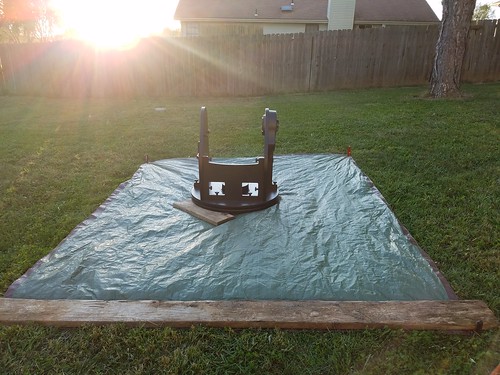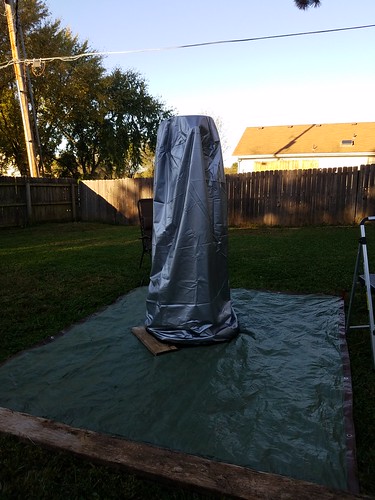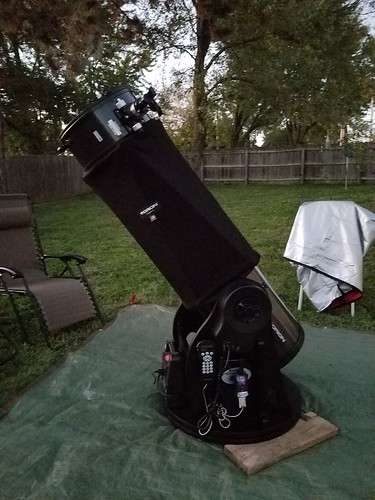
All last week, I looked forward to the weekend as a chance to get some astronomical observing accomplished. The weather forecast seemed too good to be true: Sunny and clear, highs in the mid 70s and lows in the 50s, with dew points in the upper 40s and lower 50s. My astronomy club hosted a club star party, but I did not want to lug the scope to Louisburg and share the observing grounds with a previously scheduled private party. Besides, I need to get used to operating my new scope so that when I do choose to share it with club members and the public, I don’t appear to be a fumbling idiot.

Friday evening observing turned out to be a bit disappointing. Skies were a tad hazy, and coupled with the light pollution in Lansing, meant no deep sky objects (like nebulae). The temperature also dropped rapidly after sunset to a slightly uncomfortable mid to lower 50s. I had trouble getting my tablet connected to my scope so I took a break, watched a movie, and a nap, asking my husband to wake me up at 3:00 or 3:30 a.m. in the hopes of catching Orion at transit. He woke me up as requested. I stumbled outside and confirmed that Orion was indeed high in the southern skies but when I reached to open my case of lenses, the top of it was very wet. We’d reached the dew point and everything outside was dripping wet. I left the scope covered (see photo above) and went back to bed.
Highlights of objects observed in first round:
- Double Stars:
- Achird (Eta Cassiopeia)
- Almach (Gamma Andromeda)
- Albireo (Beta Cygnus)
- Capella (Alpha Aurigae)
- Navi (Gamma Cassiopeiae)
- Variable Stars:
- Algol aka Demon Star (Beta Persei) – a triple star system with an eclipsing binary
- Caph (Beta Cassiopeiae)
- Other Stars:
- Mirfak (Alpha Persei)
- Mirach (Beta Andromeda)

Saturday evening observing went better. I got the tablet connected to the scope via portable wifi hotspot (designed specifically for this scope). I read the manual (again) and had apparently missed the step where it tells you to align the scope before you connect your tablet to the scope. I incorrectly assumed that the “Align” button in the StarSeek app was to align the scope initially. Rather, that “Align” button is to fine-tune the alignment once you are in the midst of observing. For example, when you ‘goto’ an observation target, and you observe it in the field of view of your telescope, but the object is not centered, you can center the object then click the “Align” button to reset the alignment to match.
I started observing around 9:00 p.m. and then took a break to watch a DVD followed by a short nap. I set two alarms to wake me up at midnight. I should have set it for 1:0 a.m. I ended up sitting outside in my zero gravity reclining lawn chair watching the Pleiades slowly rise over the roof of my house. Then, slowly followed by Aldebaran and finally Orion. I did catch a half-dozen meteors while enjoying the view, for an hour or so.
Sometime past two o’clock in the morning, Orion finally got high enough in the sky to clear the roof of my house and my tall pin oak in the side yard (southeastern corner of my property). I’d left the scope tracking on the brightest/middle star of the Orion’s shield for a couple of hours. Once Orion’s Belt and Orion’s Sword became visible, I redirected the scope first to the open cluster at the top of the Sword below the Belt. My second target was the Orion Nebula (M42). I had taken my glasses off to observe through the eyepiece and couldn’t read my tablet screen very well. I tried multiple times to redirect the scope, even just using the directional arrows, but I kept getting an error and the scope wasn’t moving. When I looked at the hand controller attached to the side of the scope, I realized it had gone dark! My battery had finally exhausted itself … just as I had something exciting to look at! I called Terry out to take a look at the Trapezium and Orion Nebulae before calling it a night.
After that, we disconnected the electronics and other wires from the scope and put the cover over it. My battery lasted two observing sessions (not bad for a rebuilt and reconditioned garage sale find). If I’d been thinking, I would have recharged the battery during the day on Saturday.
Highlights of objects observed during second round:
- Double stars (see previous list above)
- Other Stars
- Aldeberan (Alpha Tauri)
- Rigel (Beta Orionis)
- Messier Objects
- M45 ~ The Pleiades
- M42 ~ The Orion Nebula
- Other Objects:
- Double Cluster in Perseus
- Trapezium open cluster in Orion
- Meteors: A half a dozen or so shooting stars over the course of an hour or so naked eye observing.
Neither night afforded a good opportunity to observe nebulae or galaxies. Friday night I did peak in at the Andromeda galaxy but it was the only galaxy I could discern with the slight haze and the light pollution. I had difficulty finding any nebulae, including the Ring Nebula in Lyra, although that was blocked by my pine tree by the time I remembered to observe it. Open clusters were observable, but some globular clusters were difficult to differentiate from the slighter darker grey background of the sky. The second night stayed drier and warmer, but the wind was up a bit. If my battery had lasted a bit longer, I might have had an even better observing session.
What’s Next?
Now that I’ve gained some confidence in using the scope manually, with the hand controller and with a tablet, it’s time to plan to complete an observing award. I need to review where I’m at on completing the club’s AstroQuest observing award, which I started back in 2011. The obvious choice to start fresh with is the Urban Observing Program designed for skies just like what I see from my own backyard.
This weekend is a new moon weekend, but I have my last night of volunteering at Powell Observatory on Saturday. Depending on the weather, I may setup again in my backyard This Friday or Sunday night.

Reblogged this on As a Matter of Fancy and commented:
Cool. What we all need in our backyard.
Fantastic article! Very well written. The log capturing what you saw was very good as well. Your scope looks very nice and is something I’m looking at also. Thank you for sharing. Roger